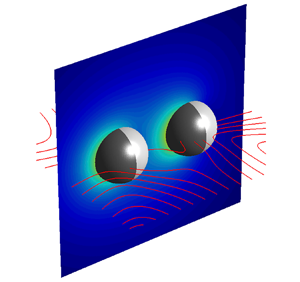Article contents
Hydrochemical interactions of phoretic particles: a regularized multipole framework
Published online by Cambridge University Press: 26 May 2021
Abstract

Chemically active colloids modify the concentration of chemical solutes surrounding them in order to self-propel. In doing so, they generate long-ranged hydrodynamic flows and chemical gradients that modify the trajectories of other particles. As a result, the dynamics of reactive suspensions is fundamentally governed by hydro-chemical interactions. A full solution of the detailed hydro-chemical problem with many particles is challenging and computationally expensive. Most current methods rely on the Green's functions of the Laplace and Stokes operators to approximate the particle signatures in the far field, an approach which is only valid in the very dilute limit in simple geometries. To overcome these limitations, we propose a regularized multipole framework, directly inspired by the force coupling method (FCM), to model phoretic suspensions. Our approach, called diffusio-phoretic FCM (DFCM), relies on grid-based volume averages of the concentration field to compute the particle surface concentration moments. These moments define the chemical multipoles of the diffusion (Laplace) problem and provide the swimming forcing of the Stokes equations. Unlike far-field models based on singularity superposition, DFCM accounts for mutually induced dipoles. The accuracy of the method is evaluated against exact and accurate numerical solutions for a few canonical cases. We also quantify its improvements over far-field approximations for a wide range of inter-particle distances. The resulting framework can readily be implemented into efficient solvers, allowing for large scale simulations of semi-dilute diffusio-phoretic suspensions.
JFM classification
- Type
- JFM Papers
- Information
- Copyright
- © The Author(s), 2021. Published by Cambridge University Press
References
REFERENCES
- 11
- Cited by





